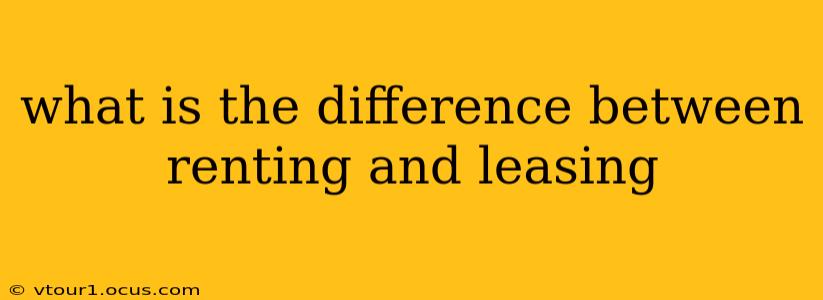What's the Difference Between Renting and Leasing?
The terms "renting" and "leasing" are often used interchangeably, leading to confusion. While they both involve the temporary use of property in exchange for payment, there are key differences that can significantly impact your rights and responsibilities. Understanding these nuances is crucial before signing any agreement.
In essence, renting typically refers to shorter-term agreements for residential properties, while leasing often implies longer-term agreements, frequently for commercial or more specialized properties. However, the legal definitions can vary depending on jurisdiction and the specific contract.
What is Renting?
Renting usually involves a shorter-term agreement, often month-to-month or for a year. It's commonly associated with residential properties like apartments or houses. Renters typically have fewer responsibilities regarding property maintenance and repairs compared to lessees. The landlord or property manager is generally responsible for major repairs. Renters have more flexibility in terms of moving out, often with a short notice period (though this can vary by contract).
What is Leasing?
Leasing usually involves a longer-term agreement, often several years. It's more common for commercial properties like office spaces or retail stores, but it can also apply to residential properties. Leases tend to be more formalized contracts with specific terms and conditions outlined in detail. Lessees might have more responsibilities regarding property maintenance, depending on the lease agreement. Breaking a lease often involves penalties, making it a more significant commitment.
What are the Key Differences Between Renting and Leasing?
Here's a table summarizing the key differences:
| Feature | Renting | Leasing |
|---|---|---|
| Term Length | Typically shorter (month-to-month or 1 year) | Typically longer (several years) |
| Property Type | Primarily residential (apartments, houses) | Residential and commercial (offices, retail) |
| Formalization | Less formal contracts | More formal, detailed contracts |
| Maintenance | Landlord usually responsible for major repairs | Responsibilities may be shared or fall on the lessee |
| Flexibility | More flexibility to move out | Less flexibility; penalties for early termination |
| Negotiation | Less negotiation room | More room for negotiation of terms |
How do the terms relate to different property types?
Residential: While "renting" is prevalent in residential contexts, leases can also exist. A long-term rental agreement, even for a house, could be legally defined as a lease.
Commercial: Leasing is the more common term for commercial properties. These agreements are usually highly detailed and specify responsibilities, payment schedules, and other crucial terms in much greater depth than a typical residential rental agreement.
What are the implications of the difference?
The distinction between renting and leasing significantly affects your rights and responsibilities. A lease provides a more structured agreement, defining responsibilities and outlining potential penalties for breach of contract. A rental agreement, while still legally binding, is often more flexible, allowing for greater ease of termination but offering fewer protections in some cases. It is crucial to read the entire contract carefully and seek legal advice if needed before signing anything.
What if I'm unsure if my agreement is a rent or a lease?
Review the contract carefully. Look for details like the duration of the agreement, the specifics of maintenance responsibilities, and the clauses regarding early termination. If you remain unclear, consult a lawyer or real estate professional. They can help interpret the legal terms of your agreement and explain your rights and responsibilities.
